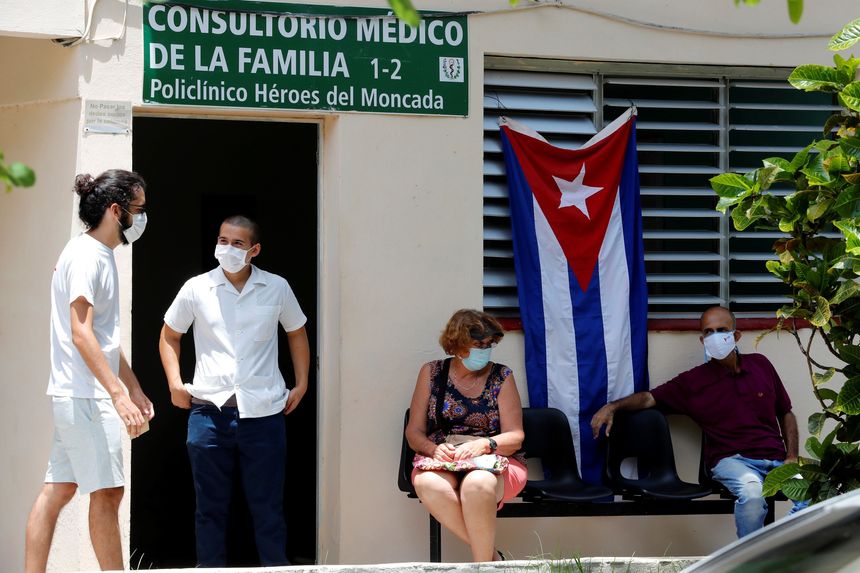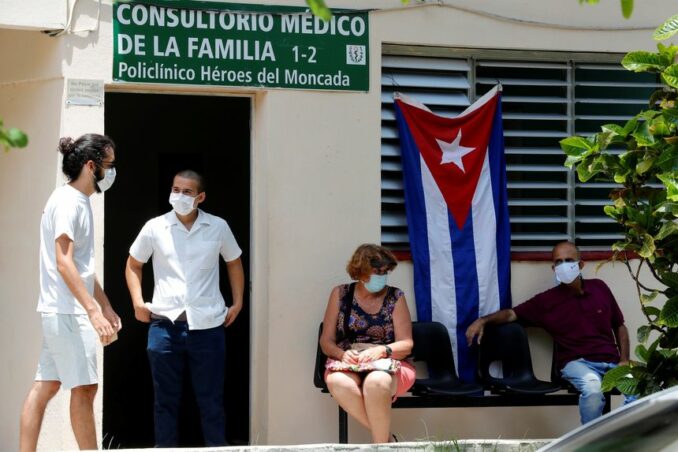

Neighborhood health care is freely available in revolutionary Cuba.


Neighborhood health care is freely available in revolutionary Cuba.
For a look at how the following figures were derived, given the difficulty of comparing data on COVID-19, see the article endnote.
On Aug. 26, CNN was running a short news report on the spike of COVID-19 in Florida, highlighting the 230 deaths that day from the virus. Suddenly, news anchor Don Lemon broke in: “There have been only three COVID deaths in China today, and it has 1.5 billion people.” Florida, according to the 2020 census, has 21.5 million people.
Lemon was obviously struck by this disparity. The question that his remark raises is broader: Are Florida’s COVID deaths unusual in this epidemic? Or are China’s?
There has been a serious struggle going on in the U.S. over how to respond to COVID, over interventions like masks, social distancing, hand washing, air purifiers and vaccinations. The factors influencing the spread and lethality of COVID are still being investigated.
One factor that doesn’t get a lot of attention is how the societies afflicted with COVID are organized, especially in their delivery of health care to their people.
According to the World Health Organization, as of Aug. 28 there have been 216 million cases of COVID and 4.49 million deaths worldwide. WHO admits there is a lot of imprecision in these figures. For example, some countries do very little testing, so their declared caseload is low. If there are multiple factors, such as a heart attack in a COVID patient, it can be difficult to decide which health problem caused the death.
But however imprecise the calculation of the pandemic death rate, at an official 2.08% of people who have contracted COVID-19, the disease is a much more serious illness than influenza, when the death rate is a fraction of 1%.
But comparing the death rates due to COVID between different countries — as imprecise as the figures are — will still get at real differences. For instance, a deliberate undercount of COVID deaths can be revealed when epidemiologists examine “excess deaths.”
So looking at two groups of countries can show remarkable differences in their response to COVID. One group consists of the United States, Brazil, India and the European Union, considered here as a country since it has a centralized statistical service for economic and health data.
The collective population of these capitalist countries, some of which are the most prosperous economies in the world, is over 2.65 billion. Since the beginning of the pandemic 18 months ago, they have recorded over 128.52 million COVID cases and over 2.4 million COVID deaths. (These figures are from the end of August 2021.)
Press reports in June and July raised the question of whether India was undercounting COVID deaths by hundreds of thousands for a number of political reasons. But Worldometer and the Johns Hopkins Coronovirous Resource Center appear to be sticking to the data India supplied to the World Health Organization.
Another group to be considered consists of countries which can broadly be called socialist, progressive or structured with planned economies — China, Vietnam, Cuba, Venezuela and Nicaragua. These countries are much poorer than the first group. Their total population is over 1.54 billion, about 1.1 billion fewer than the first group. Since the beginning of the pandemic 18 months ago, this group has recorded over 1.5 million COVID cases and 24,505 COVID deaths.
Even given the population difference, the difference in the number of those dying in the two sets of countries is dramatic — particularly if China’s enormous challenge in dealing with its large population is considered.
Even if the figures are not absolutely precise — given many factors including rapidly changing circumstances — they can still highlight the differences between how socialist and progressive countries care for and preserve the health of their citizens — and how capitalist countries fail the people who live under that exploitative system.
A note from the writer on the figures: “I created a spreadsheet using data from the following websites worldometers.info/coronavirus/, statista.com/topics/5994/the-coronavirus-disease-covid-19-outbreak and coronavirus.jhu.edu/. For the EU, I used their statistical service ecdc.europa.eu/en/covid-19/situation-updates/. For the United States I used covid.cdc.gov/covid-data-tracker/. For population figures I used data.worldbank.org/indicator/SP.POP.TOTL?locations=1W. I also used the World Bank to get GDP figures for each of the countries included in the spreadsheet.”
In the 1950s, when Japan and much of Europe was in ruins, the U.S. accounted…
This “Call from the General Federation of Trade Unions in Gaza to Labor Unions in…
Desde que la administración de Donald Trump/Elon Musk tomó las riendas del poder a finales…
Philadelphia Palestine activists marched from Philadelphia City Hall to Day & Zimmermann on April 18…
Marching up Blue Hill Avenue. through the Black and immigrant Dorchester neighborhood, Trans Day of…
This statement was recently issued by over 30 groups. On Friday, March 28, Dr. Helyeh…